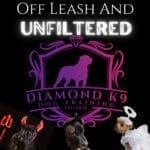Obsessions, Addictions, and Impulse Control: How to Fix the Real Problem

/
RSS Feed
In this Off Leash and Unfiltered episode, Kati Peppe—owner of Diamond K9 Dog Training in Biddeford, Maine—tackles dogs who are stuck in obsessive, addictive loops: reactivity like a “drug,” shadow/light chasing, water or ball fixation, and destructive chewing. The fix isn’t more management or endless commands—it’s changing the dog’s state of mind through structure and real impulse control: clear No + meaningful correction, practiced all day (doors, food, kennel, car) and, for “sometimes-allowed” things like balls or swimming, using commands with true accountability.
Episode Highlights
- Obsessions are addictions: For many dogs, reactivity or chasing light/shadows “pays” like a high. Treat it like addiction.
- Small moments matter: Door rushing, food surges, car/kennel excitement, yard exits—these daily reps either feed or starve the obsession.
- Structure ≠ robot: Crate, place, threshold rules, calm leash starts reduce arousal and anxiety so dogs can choose calm.
- Direct correction beats spoon-fed commands: “No” → meaningful consequence changes behavior faster than holding the leash tight or chanting cues.
- When it’s never allowed: Tail chasing, light/shadow fixation, furniture destruction—mark No and give a high correction (e-collar/bonker/firm leash pop; used safely).
- When it’s sometimes allowed: Ball/water—teach down, out, and place, then correct breaking command around the trigger (impulse control).
- Don’t strengthen impulses by restraint: White-knuckle leash holding creates frustration; aim for calm neutrality with clear consequences.
- Rewrite bad associations: Patterns aren’t permanent—install new ones with reps, clarity, and follow-through.
How to Correct an Obsessive Behavior (Never-Allowed Cases)
- 1) Mark: Say No neutrally the moment the behavior starts.
- 2) Correct: Follow with a meaningful correction (often e-collar at a high, safe level; or a firm prong-leash pop; or a rolled-towel bonk). One clear message beats nagging.
- 3) Resume normal: No drama, no yelling. Calm handler = faster learning.
For “Sometimes Allowed” Stuff (Ball/Water): Train Self-Control
- Install commands: Down, Place, reliable Out/Drop.
- Proof with accountability: Bounce/roll/throw the ball or approach water; correct breaking position or refusing Out.
- State of mind work: Teach quiet lounging near the trigger (no fixating/whining)—advanced e-collar/handler skills help here.
Minute-by-Minute Breakdown
- 01:24 – What counts as an obsession: reactivity, water/ball fixation, lights/shadows, destructive chewing.
- 03:00 – Why “small” daily moments feed big problems; mindset doesn’t live in a vacuum.
- 04:37 – Structure isn’t control-freakery; it’s how you stop nurturing the addicted brain.
- 05:56 – Reactivity as a drug: the scanning, pupil dilation, breathing tells.
- 07:24 – Addiction model: board-and-train improves patterns; relapse risk if home life ignores the little moments.
- 09:37 – Attack from all angles: lifestyle rules + training, not one behavior in isolation.
- 10:39 – Owner story: destructive dog vs. structured boarding; history with the owner matters.
- 12:01 – “Not quite right” dogs: anxiety/antsiness under the hood even after the surface problem is stopped.
- 13:17 – Rehab analogy: in recovery they remove all highs; for dogs, stop the substitute thrills too.
- 17:04 – Apply it to dogs: don’t allow “harmless” hype that fuels the same circuitry.
- 23:43 – Correction protocol: No → high, safe consequence for never-allowed acts.
- 26:26 – Caveats for ball/water: commands + accountability around the trigger.
- 30:17 – Practice impulse control at doors, food, kennel, car—not just around the hardest trigger.
- 31:36 – What everyone misses: corrections (not leash-restraint or cue-spamming).
- 32:44 – Why tight leashes fuel drive; commands alone are spoon-feeding, not choice-changing.
- 34:49 – Food-bowl example: light correction for advancing, then release to eat.
- 36:43 – If it’s allowed sometimes: correct breaking command, not the interest itself.
- 38:49 – You decide when excitement is allowed; enforce it so calm becomes default.